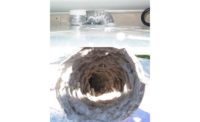“The assessment in itself is its own business. I can’t emphasize this enough.”
Tom Yacobellis, ASCS, of DUCTS North America wants ventilation pros to avoid the first potential pitfall on most jobs. Do a professional ventilation inspection. If all goes well, identify the root problem of whatever was concerning the customer, and sure, that might indeed lead to doing the remediation or replacement work.
Just don’t treat the detective work as just the first phase of remediation or restoration.
“We may not even get this job at this point,” he explained to a group of virtual attendees at the recent National Air Duct Cleaners Association (NADCA) event. But it is easy to get ahead of yourself, he said.
“What I see as a problem for the industry is that members are so busy that they don’t have the time to actually do these assessments. It’s like, ‘OK, let me just give you a price and we’ll do this as our next job. So the whole assessment phase, if it’s done at all, is very brief.”
Instead, Yacobellis encourages contractors to slow down, and break down this sequence of events. Give an assessment. Then give a scope of work. Then give a price for what that work would cost.
The 6-Inch Rule
For commercial buildings with problems, Yacobellis offered another reason to break this phase out. A ventilation inspector or remediation expert has more clout than they might think.
“It’s something the industrial hygienist really can’t do.”
Yacobellis shared a case where his firm assessed and then told the industrial hygienist, “You tell us what to do.”
That firm, in turn, went back to try to “write up a high-end protocol” only to come back and say, “let the air conditioning guys tell us what to do.”

Mike McDavid of Professional Abatement and Remediation Technologies.
Mike McDavid, ASCS, CVI is a technical sales rep at Professional Abatement & Remediation Technologies. He reminds contractors that possibly leaving money on the proverbial table is not the only reason to slow down the process, or their thinking about the process.
Breaking the assessment off as its own task, he said, is also critical to avoid being vulnerable to trouble or litigation without knowing exactly what you’re dealing with. A thorough look beforehand can avoid unwanted situations such as, but not limited to, stirring something up in the system that causes more problems or introduces the existing problem into new spaces.
To further encourage not rushing past this step, McDavid cited NADCA’s ACR 2013, the international standard for HVAC assessment and restoration. After all, Section 1, he said, talks about inspections.
McDavid also offered a couple of tips in dealing with the customer.
“Ask the same questions several different ways to make sure you’re catching everything you need to know,” he advised. People don’t intentionally set out to withhold key information, but gathering the essential info can require some strategy.
Back inside the system, visual documentation is more important than ever. Yacobellis told contractors to remember what he calls the 6-inch rule when taking a photo of a trouble spot in the ductwork, such as some damage or of some microbial growth. Get up close and personal, within six inches of the object.
It is hard to train people to do it, he said, because a shot from further away tends to look fine to the photographer who can also see the location right there. But getting closer, he said, makes the difference in conveying the reality of the situation to the owner.
“One picture is worth 50 if it’s the right picture,” Yacobellis said. “If it tells the story of the assessment, one picture is all you need.”
An Early Leg Up Pays Off
“It’s not easy to retrain yourself to stop and say, ‘We’re doing an assessment now,” Yacobellis told NADCA members.
He said he envisions himself wearing a hat with two different bills on it — one strictly for assessments, to work with an environmental consultant or other contact as needed and outline the scope of what a customer’s project is or should be.
For those who can do that much, doing the assessment provides another built-in advantage. Yacobellis points out that while the resulting quote could be much higher or much lower than someone else’s quote to complete the scope of work, “You’ve been right up in there. You know what it’s going to take.”
It will also help that you have served as the owner’s liaison for getting to the truth of whatever is happening. The assessment process lets a contractor establish personal trust, McDavid pointed out.
“They will trust that you’re the guy, when you show them what will and won’t work” and why, in your estimation.
Dexter touched on another way that getting that initial call, defining an assessment as its own task, and establishing your expertise by identifying the problem can pay off later.
“If you’re just focused on selling products, that’s all you’re ever going to do,” Dexter said.
“But if you really focus on what the issue is,” he said, “you don’t have to sell anything. The sale is in the solution.”










